I tried playing 'Warchest Japanese version' aiming to control the battlefield by making full use of luck and strategy packed in the treasure box

The Japanese version of the board game 'War Chest', which uses various units to fight on the field of hexagonal squares, will be released by
War Chest – ALDERAC ENTERTAINMENT GROUP
https://www.alderac.com/warchest/
A sample of the Japanese version of war chest is now available! If all goes well, the product will arrive at our store in early April. After inspection, we will inform each store and start making reservations at our store! #Naganos #Board game pic.twitter.com/9RmQaPp4Mj
— Board game cafe nostalgia Nagaizumi store (@nostalgia_naga) March 24, 2021
The war chest package looks like this. It looks like a treasure chest.

The number of players is 2 or 4, the play time is 30 to 60 minutes, and the target age is 14 years old or older.

The lid is equipped with a magnet so that it can be fastened perfectly.
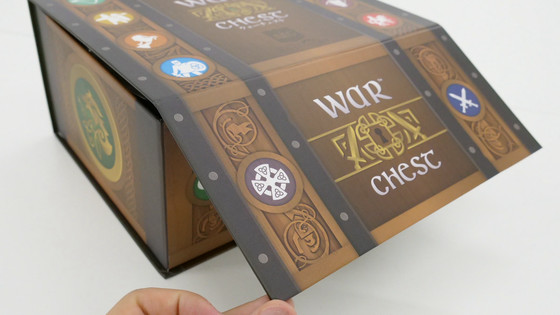
When you open it, it looks like this. It's exciting as if you were opening a treasure chest.

According to the explanation written on the back of the lid, this war chest is a replica of 'a tool for teaching the children of the king who will carry a certain country in the future, the strategy of war'.

The contents are a rule manual and four bags. The wolf and crow marks are embroidered on the bag.

Unit cards, occupation markers, game boards

When you open the game board and compare the size side by side with the iPhone 12 mini, it looks like this.

And a coin tray filled with 16 types of unit coins, royal coins, and initiative coins.

When you put one coin on the palm of your hand, you will feel a heavy weight.

When we weigh one piece, the actual measurement is 13g, which is about two pieces of 7.0g of 500-yen coins.

When we weighed each tray, it exceeded 1 kg in total.

◆ Play preparation
The war chest is '2 or 4 players', so I played with 2 players. First, deal Royal Coins and 6 Occupation Markers to the Wolf and Crow camps, respectively.
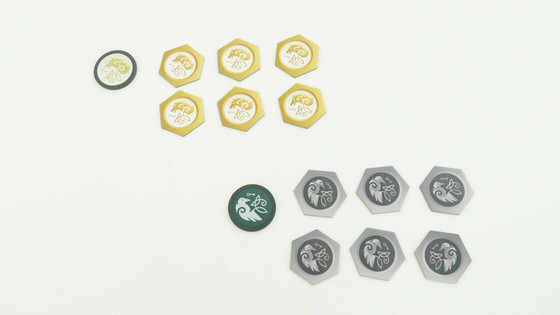
Place two of the six Occupation Markers in the red frame on the board. In addition, when playing against two players, the dark brown squares at both ends are not used.

Distribute 4 unit cards and corresponding unit coins to each camp. There are 16 unit cards in total, and


In addition, we will give out royal coins to each camp. The royal coin has its own camp icon drawn on one side, and the other side is the same as the back side of the unit coin.

Then, take two of your own unit coins from the supply and put them in the bag with your royal coins.

This completes the setup.

Before starting the game, toss the initiative coin with the wolf camp mark and the crow camp mark on both sides to decide the first player.

The game is very simple, just repeat the 'draw phase' and 'play phase'. The winner is the player who puts all the occupation markers he has on the field first.
In the draw phase, each player draws three coins from the bag at the same time.

In the play phase, the three types of 'arrangement Action,' 'action to discard a coin to face up,' 'action to discard the coin face down', each player will run alternately. Each action consumes one coin from your hand, so the play phase ends in three turns.
In ' Placement Action ', you can place unit coins on the board from your hand. However, one unit can only exist in one place and can only be placed on the Occupation Marker. It cannot be placed if another unit coin is on the occupation marker.

You can also place the unit coins in your hand on the same unit coins on the board. One unit coin must be removed from the board when it is attacked (described later), and if there is only one unit coin, the unit will disappear. However, if you have multiple coins on board, the unit will not disappear even if you are attacked.

' Action to discard coins face up ' is to move coins of the same type as the discarded coins by one square or attack adjacent enemy units by discarding coins from your hand face up and discarding them in the coin storage area. I can.

In addition, each unit has a special ability called 'tactic', which can be used in the action of discarding coins face up. For example, the orange 'Cavalry' tactic is to 'move and then attack.'

For example, in the following situations, in order for Cavalry to attack the purple crossbow man, it would normally require two actions, 'move' and 'attack'. However, if you use Cavalry's tactics, you can move and attack at the same time, so you can eliminate the crossbow man with one action.

The attacked Crossbowman will have one coin removed from the board and returned to the coin tray. This removed coin will be removed from the game and will never be returned.
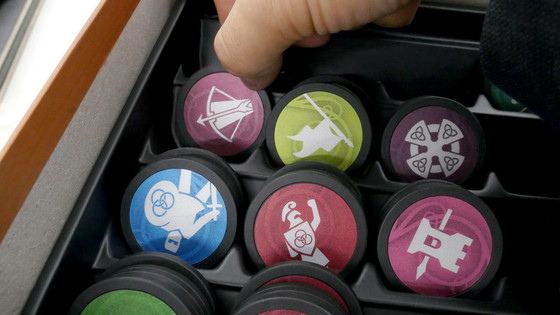
The number of unit coins is fixed and is written on the upper left of the unit card. There are up to 5 crossbowmen. Of course, if you stack Crossbowman coins in the placement action, you will not be out with a single blow, but if you stack all the coins on the game board, there will be no coins for moving, attacking, and tactics. In addition to that, the probability of drawing it into your hand will decrease. The point of this game is how to manage a limited number of coins.

Swordsman's tactic is 'you can move after attacking', which is the opposite effect of Cavalry.

In the following situations, Swordsman attacks and eliminates the adjacent Lancer (red) ...

You can move further.

The tactic of the yellow-green 'Light Cavalry' is to 'move 2 squares'.
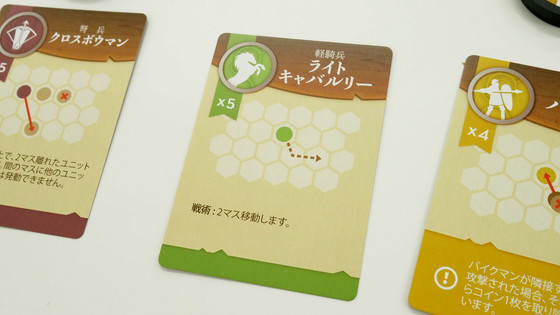
Originally, a unit can only move 1 square per turn, but by using tactics, it can move 2 squares as shown below.

The symbol drawn before this light cavalry has moved is a mark indicating 'base mass'. When you select the action to discard coins face up, if you have the same type of unit coins as the discarded coins in this base square ...

It is possible to occupy the base mass. Place your camp's Occupation Marker on the board.

The Action to Discard Coins Face Down allows the second player to steal the initiative coins and make them their own. This initiative coin-stealing action can only be performed once per round.

In addition, the action of discarding coins face down allows you to perform 'conscription' by discarding any unit coin from the supply and placing it in the coin storage area.

The game progresses by repeating the draw phase and the play phase, but since the coins in the bag are limited, the bag will eventually become empty as you use it. In that case, you will have to put all the coins in the discarded coin storage into the bag and draw your hand. Conscription increases the number of unit coins in the bag, which leads to an increase in strength.

I will proceed with the game like that.

Unit coins are confused on the front line as they collide with each other in search of a base.

When Crossbowman, who has the tactic of 'attacking units that are two squares apart in a straight line,' attacks the units of the wolf camp, the wolf camp's occupation marker becomes naked. This attack is a great opportunity for the crow camp, as it is possible to occupy a base even with the opponent's occupancy marker.

The swordsman who was in the back gently approaches, but in fact the archer who was placed behind by the wolf camp attacks the swordsman with the strategy of 'attacking the unit at a position 2 squares away'. Swordsman, who had two coins stacked, will have one coin peeled off.

However, the crow camp that does not give up the occupation marker moves the swordsman one more time to reach the base. Now, if you draw Swordsman's coins into your hand, you can occupy this square with the action of discarding the coins face up ...

Archer, which is upward compatible with Crossbowman, is characterized by its tactics that it can attack two squares ahead even if it is not a straight line. Since this base mass is also within Archer's attack range, Swordsman disappeared from the battlefield without being able to occupy the base.
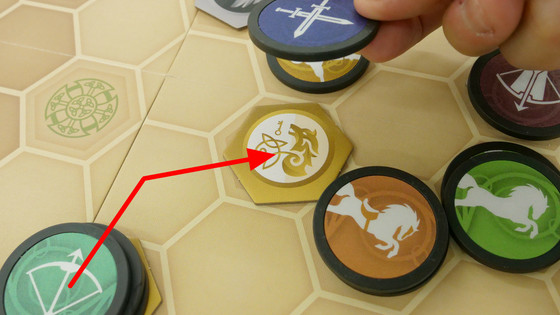
… And, behind the wolf camp's splendid defense of the base, the crow camp noticed that the wolf camp's base in the back was actually empty. Using a light cavalry that can move 2 squares, he attacked the depths at once and succeeded in seizing the base. This concludes the victory of the crow camp with all 6 Occupation Markers.

In the case of 4 players, play with 2 players from each camp. The important thing is the sitting position, and you need to sit around the board in a staggered manner so that each side's turn alternates. You need to work together to play, but you can't talk to him because the same camps aren't next to each other, and strategic counseling must always be open to the enemy camp.

Also, the fact that there are 3 unit cards each is different from a two-player match. Also, the number of occupation markers will increase to eight.

In a four-player match, the field becomes wider, which makes it more strategic. The following green unit 'Footman' can be placed in one field, and has a powerful strategy of 'you can make two units act in one action'. Therefore, it is possible to occupy two bases at once as shown below. You can advance the widened field to your heart's content.

The blue unit 'Scout' of the wolf camp attacks the pink 'Royal Guard' sitting on the base with the aim of seizing the base of the crow camp. Since there is only one royal guard, I think it will be eliminated here ...

The royal guard has the characteristic that 'even if it is damaged, it consumes the coins in the supply instead of the coins on the board'. Therefore, it was not necessary to seize the base.

On the right side, which became thin in the meantime, another player of the crow camp seized the base with a lancer. The crow camp dared to 'consult only the strategy on the left side of the board' because it was unpretentious that Lancer was aiming steadily. The demonstration battle was proceeding silently, and the crow camp said, 'I imagined what I wanted to do with each other and managed to connect well,' said the victory comment.

When you actually play, one play is about one hour. The rules are very simple and easy to understand even for those unfamiliar with board games. However, there are various strategies depending on the combination of unit cards, and it can be said that the replayability is quite high.
The part of 'drawing 3 cards in the draw phase' is important, and this draw phase is a luck factor that determines the outcome of the battle. However, it is not completely reliable and the number of unit coins is limited, so 'what kind of coins the opponent recruited and how many coins were used' and 'how many coins were used and how many were eliminated' are firmly determined. It is also necessary to look and imagine the opponent's hand to select a more advantageous strategy. The balance between this luck and strategy is very good, and even if you are unlucky, you can cover it with strategy, or you can turn over a situation that can not be helped with luck, and you can expect a very hot game development.
In addition, it is a nice point that the components are high, from heavy coins to boards to packages. Normally, if you use a card in your hand, the card may break or bend if you play it many times, but since it is a durable coin that you use as a hand, it is also attractive that it will not be consumed even if you play it many times.
The Japanese version of the War Chest will be released in early April 2020. The suggested retail price is 6000 yen excluding tax. Reservation has not started at the time of writing the article, but it is said that reservation information will start as soon as the inspection is completed, so if you are interested, please check the official website of board game cafe nostalgia and Twitter.
The suggested retail price without tax is ¥ 6,000!
— Board game cafe nostalgia Nagaizumi store (@nostalgia_naga) March 24, 2021
Related Posts:







